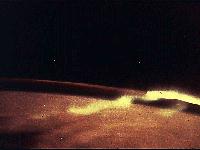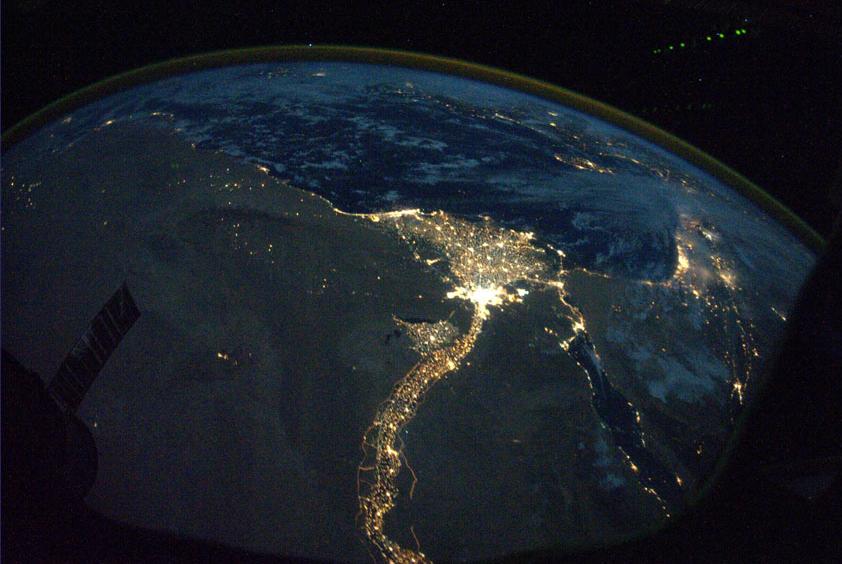Airglow viewed from space. The orangish arc extending to the left from the aurora is airglow viewed edgewise on the limb of the Earth.

Another nice shot of airglow visible on the horizon and the lights along the Nile in the center of the picture

Airglow: The Movie Video and commentary from the Int'l Space Station by astronaut Don Pettit and another nice video
Also take a look at NASA's Space Station Science Picture of the Day for April 11, 2003 and another and another nice shot (scroll down to second picture)
- Dayglow (when entire atmosphere is illuminated by the Sun) is the brightest airglow due to the importance of RESONANT and FLUORESCENT processes (see below) but it is overwhelmed by direct and scattered sunlight
- Twilightglow (when only the upper atmosphere is illuminated) is the most readily observable airglow from the ground since the observer is in darkness (and Rayleigh scattering of sunlight by the dense lower atmosphere is absent) while the airglow region of upper atmosphere is still illuminated
- Nightglow (when entire atmosphere is in darkness) is not as bright as dayglow since CHEMILUMINESCENCE (see below) is the dominant process; however contributes more light than starlight to the total luminosity of the night sky
- spatial extent: global vs. high latitude
- luminosity: relatively uniform vs. highly structured
- energy source: solar radiation vs. solar wind
- RESONANCE: emitted light is at same color as that absorbed resulting from excitation by the absorption of solar radiation
- FLUORESCENCE: emitted light is at lower frenquency, i.e. a different color, resulting from excitation by the absorption of solar radiation
- PHOTOIONIZATION: emitted light is from the excited states of ionized fragments caused by solar radiation
- PHOTODISSOCIATION: emitted light is from the excited states of neutral fragments caused by solar radiation
- INELASTIC COLLISIONS: emitted light results from excitation caused by the impact of high energy ("hot")
electrons that are produced in photoionization [NOTE: This is the same
process that causes the luminous aurora but in that case the "hot" electrons
come from the magnetosphere through interactions with the solar wind.]
- CHEMILUMINESCENCE: emission results from chemical reactions mainly
between oxygen and nitrogen atoms and molecules and hydroxyl molecules at a
height between 100 and 300 kilometers. Solar radiation energy breaks molecules
apart during the day, and it is their recombination, which is accompanied
by the emission of light, that generates the nightglow.
- EXCITATION by COSMIC RAYS (high energy radiation and particles from outside the solar
system) make a small contribution to airglow as well.
- Gravity waves generated by strong thunderstorms or, as pictured in the link, strong winds encountering mountains have a rippling effect in the upper atmosphere like a stone thrown into a pond.
- During magnetic storms the airglow at mid-latitudes is
modified by heating effects, producing stable auroral red (SAR) arcs (as seen on the right edge of the image).
These are broad diffuse arcs of light that align along
geomagnetic parallels between about 40-55 degrees and located at a height of
300-400 kilometers. They are quite bright in red oxygen emission but
are subvisual because the human eye's sensitivity at that wavelength
is only about 5% of its peak sensitivity in the yellow region of the
spectrum.
